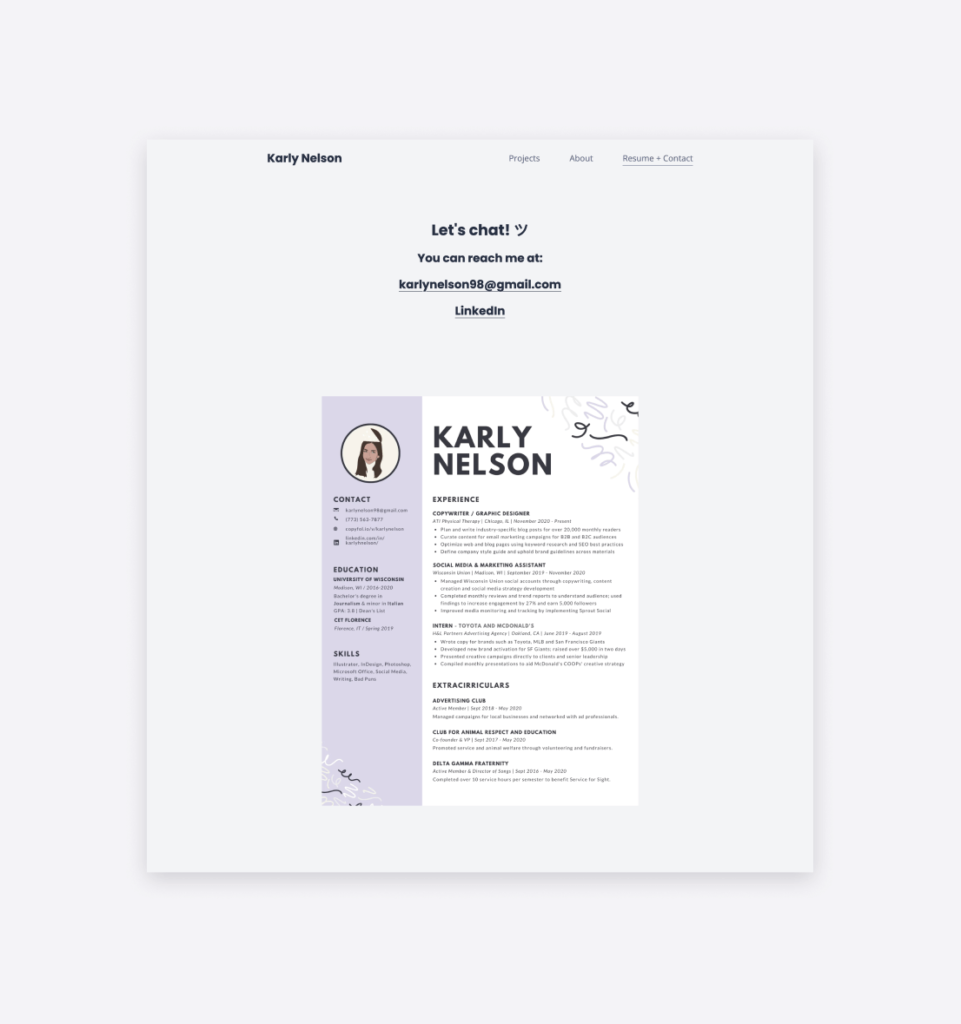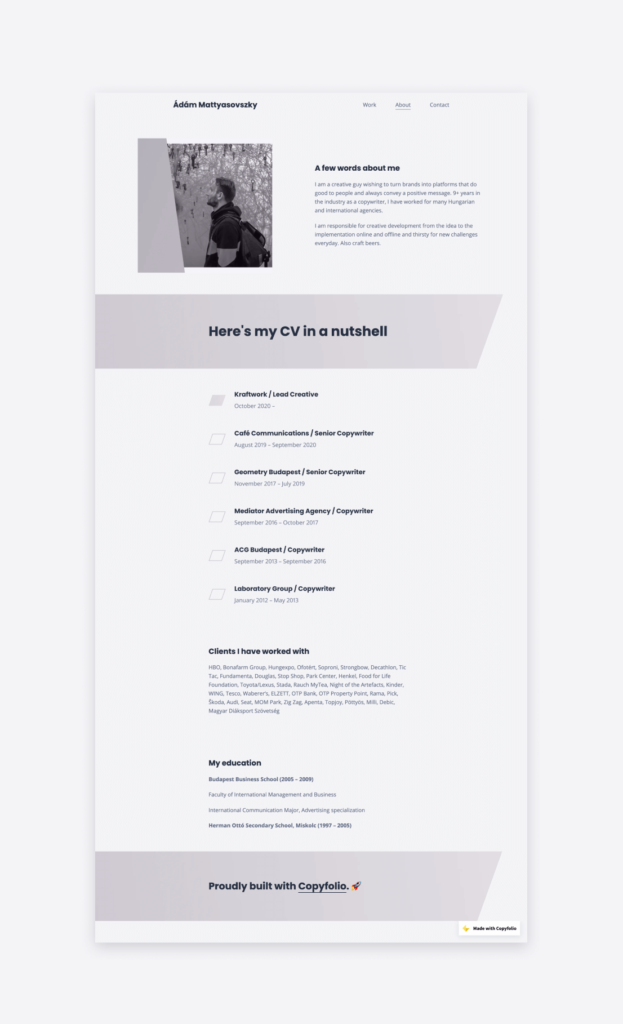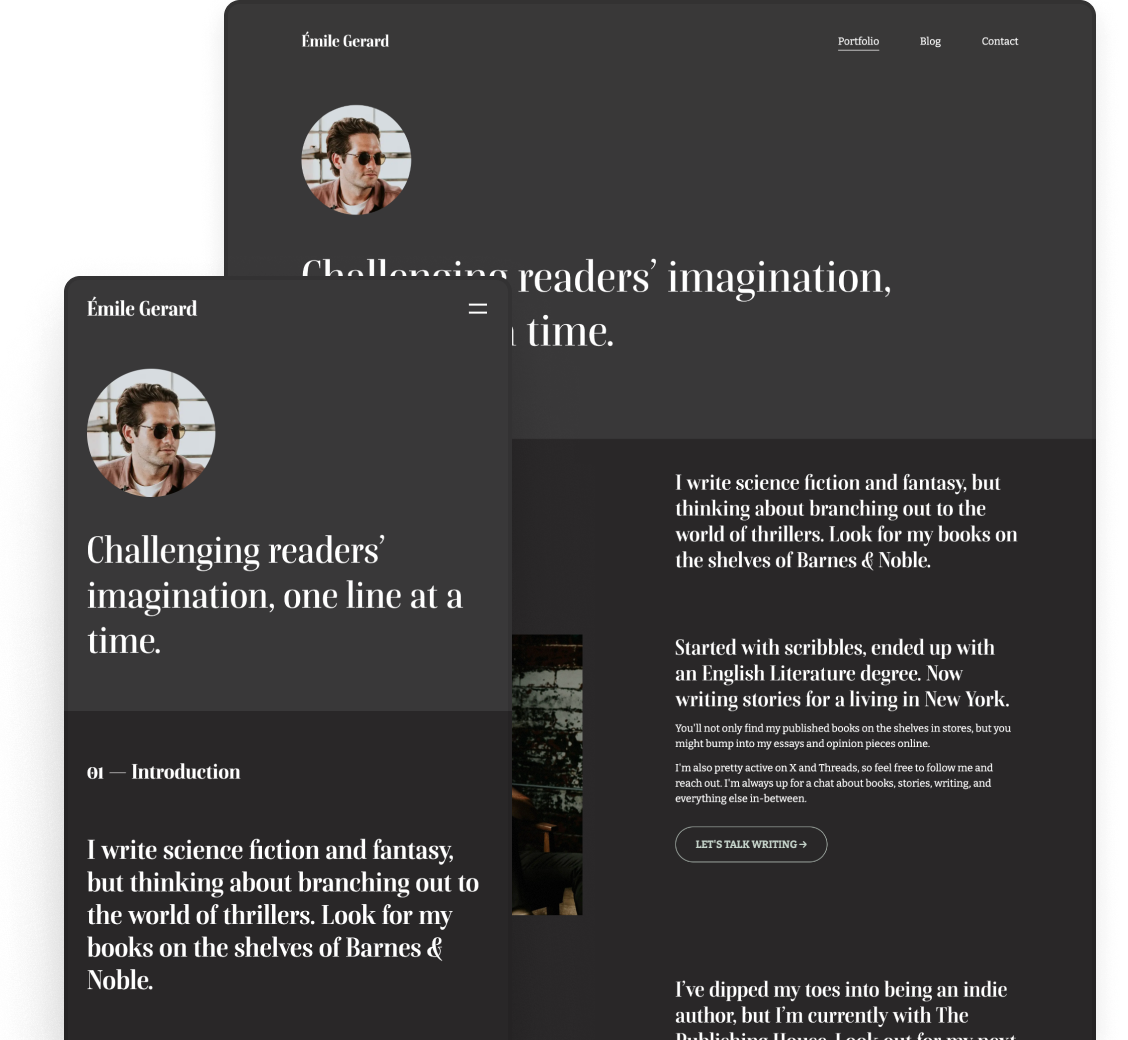Being a professional writer doesn’t mean all forms of writing come naturally. As if writing about ourselves wasn’t a challenge in itself, writer resumes have a very specific format that makes them all the more difficult to perfect. Not to mention that they also have to be convincing and compelling to ensure we get the job we applied for.
In this post, we’ll walk you through everything you need to know to create an impressive writer resume. We’ll cover what to do if you don’t have much work experience, and what skills you should showcase if you’re a copywriter, content writer, or technical writer. We’ll show you how to impress recruiters and put the cherry on top with your writing portfolio.
Start out strong: get your resume summary or objective right
As with every piece of writing, it’s important to start your resume strong. The first part everyone will read is the paragraph at its beginning that people refer to as the resume summary or resume objective. You can quickly generate your first draft using an artificial intelligence resume builder.
What’s the difference between a writer resume summary and objective?
If you think about it, the words themselves kind of hold the answer to the question. A summary aims to briefly tell you all that’s happened or been written before —while the objective talks about all the aspirations one has and the goals they’d like to achieve.
If you’re an experienced writer, we recommend that you write a resume summary. In 3-4 sentences, write about what kind of writing you do, where or for whom you’ve worked, and what your biggest achievements are. As much as possible, try to lead with the latter.
Everything else they can easily see (and expect) from the rest of the resume. But it’s your top achievements and unique skills that are going to lure them in.
If you’re still at the beginning of your writer career, aim for the resume objective. While you can write about what kind of writer you are, try to focus on your areas of interest, where you want to get to, and what you’re doing right now to get there.
Choose the best writer resume format: the difference between in-house and freelancer resumes
Since you’ve already started researching resumes, hence why you’re here, you must have heard about the most common resume formats: the reverse chronological, the functional, and the combination resumes. But which one would be the most suitable for you?
That depends on two things. It depends a little bit on how much experience you have —as writing a reverse chronological writer resume would be challenging at the start of your career. But even more so, it depends on whether you’re an in-house or a freelance writer.
Reverse chronological resumes for in-house writers
For in-house or agency writers, the reverse-chronological format fits perfectly. In this method, you’re listing your previous work experiences, starting with the most recent one, working your way back in time. For each, you add the professional title you had (e.g. senior content writer), the name of the company you worked for, and the date when you worked there.
To maximize the impact, add a little summary or bullet list of the highlights of the position: what skills you used and gained and what you achieved here.
Functional or combination resumes for freelance writers
For freelance writers, functional or combination resumes work much better. That’s because as a freelancer, you work for multiple different clients and agencies, often overlapping with each other. That makes for a tangled, messy timeline that’d be impossible to represent in a traditional, chronological resume.
Functional resumes focus on your skills instead of the timeline of your work history. You can write about the types of projects you’ve done (e.g. writing email marketing sequences, advertising copy, or eBooks), then possibly list the brands and clients you’ve done them for.
Or instead of/additional to the project types, you can also list and write about skills that make you a better candidate than all the other writers applying for that gig. Having good writing skills is just the baseline after all, so emphasizing what else you can do is crucial.
Combination resumes, as the name gives it away, combine the two formats. They often lead with the skills, but then go on to list some previous positions as well. See which one makes more sense for you, depending on your career and the position you’re applying for.

The writer resume of Karly Nelson, featured on her portfolio website created with Copyfolio
Impress them with the results: include numbers and achievements
Whichever format you choose, you’ll have to go beyond a list of skills or places you’ve worked at. With each, you’ll have to write short summaries —an explanation, so to say. And that’s probably the most important part of your writer resume. After the very first paragraph, of course.
Because at the end of the day, when someone’s looking at your writer resume, they’re looking to see what you can bring to them and their business. They’re going to be looking for numbers and achievements, not the laundry list of previous companies you worked for.
So instead of just saying you wrote blog posts and weekly email updates, write about how many organic visitors your blog posts brought in, or how your emails boosted sales by X%. Try to aim for something tangible that can be related back to business goals and performance.
Include the right skills: what each type of writer needs on their resume
Another thing not only clients and recruiters but their ATS (Application Tracking System, a software that scans writer resumes to filter which ones actual humans will get to see) is looking for, will be the right skills.
This includes both soft and hard skills. These can show them whether you’re going to be a good team fit, and what else you can do apart from writing. Because if you’re applying for a writing job, having solid writing skills is a given.
The kind of skills they’ll be expecting to see on your resume will depend on what type of writer job we’re talking about. To give you a better idea and more specific tips, we analyzed dozens of job posts to see what the most commonly mentioned skills are for each.
Content writer skills
- Impeccable attention to detail
- Proven ability to meet deadlines
- Hands-on experience with Content Management Systems (e.g., WordPress)
- Strong research skills, using multiple sources
- Experience with SEO
- Familiar with most social media platforms
Copywriter skills
- Highly organized with excellent time management
- Thrive in the fast-paced, constantly changing environment
- Strong attention to detail, spotting typos from a mile away
- A positive can-do attitude, always eager to learn
- Interest in the latest creative and editorial styles
- Managing multiple projects with the ability to switch from one to the other whilst keeping on top of all deadlines.
Technical writer skills
- Strong research and analysis skills
- Interpersonal and communication skills
- Excellent attention to detail
- Flawless grammar and great editing skills
- Experience with formatting and design software
- Coding and IT skills, such as writing HTML
Convince & convert them with your writer portfolio
No matter what skills, experience, and education companies require, there’s one thing they never miss from writer job ads. And that’s the writing portfolio.
Because regardless of what you write on your CV, it is the writing samples that truly prove your skills and expertise. Potential clients and employers like to see your writing style in action, whether you can take on the tone of voice of different brands, and produce high-quality pieces free of errors.
So having an outstanding portfolio, and sending it in alongside your resume will be crucial to your success.
What to include in a writing portfolio
First and foremost, your writing portfolio should showcase your very best writing pieces. It’s important to keep your standards high here, and only include ones that you’re really proud of. It’s better to have fewer samples when each of them wows the reader than adding more just for the sake of it. Don’t leave anything in that’ll make them feel it was “just okay”.
Apart from your top writing samples, your portfolio needs to tell the viewers a little bit about you. While you have very limited space on your writer resume, in your portfolio, especially if it’s a writing portfolio website, you can write a little more freely. We recommend you write a short intro (about 2 sentences) on your home page and a few hundred words on your about page.
Don’t forget to add your contact information either! Once they’ve reviewed your work, if it seemed promising, they’ll want to contact you. Make it as easy for them as possible, and add a contact page —or your email address to the bottom of all your pages.
How to create a writing portfolio
With the right website builder tool, creating a portfolio website shouldn’t take more than 20-30 minutes. If it loads quickly and is easy to use, all you’ll have to do is prepare your samples and write a few sentences about yourself. Then paste them all in.
That’s exactly how it goes with Copyfolio. Creating a writing portfolio website there looks like this:
- You sign up (takes literally 2 minutes, we timed it) and choose a template you like and we prepare your site for you in the background.
- You’ll start out with home, about, and contact pages, and your first task will be to fill them with content. Don’t think too much: a tagline for the home page, your email address for your contact page and a little introduction to the about me page will do.
- You can then add and publish your writing projects: it can be in the form of a PDF, external link, or a case study page. If you choose the latter, Copyfolio will have prompts and guiding questions to help you write it as quickly and effortlessly as possible.
...and there you have it. All you have to do is to send a link to your portfolio alongside your writer resume. Or even better, since it’s not a PDF but a website, you can link to your portfolio straight from the CV. You can update the content anytime, no matter when you sent out the resume with the link itself.
Try out Copyfolio for free, create a stunning writing portfolio easily!
Always be on-point with a tailored writer resume
After all that this might sound controversial, but having a well-thought-out writer resume with a cool portfolio is not enough in itself. If you want to aim for perfection and do everything you can to get the job you want, you’ll have to tailor your resume each time.
What that means is that you shouldn’t just have one version of your CV that you send everywhere. Instead, you should always create a new version that you tweak a little, based on that specific job post. Check what keywords they use and skills they want you to have, and emphasize those along the way.
It’s also a good idea to write a tailored cover letter to go with each application, even if they don’t ask for it. That gives you a chance to elaborate on all the details that didn’t fit into the CV, and shows them that you took the application seriously.
Learn how to create a writer resume: PDFs and website pages
There are two main ways for creating a writer resume.
One, the more traditional, is to create a PDF document. You can do that using a design software like InDesign or Canva —or even just Word or Google Docs, saving it as a PDF. If your editor doesn’t export properly, you can also use an online Word to PDF converter to quickly turn your resume file into a professional-looking PDF without losing formatting.
Application Tracking Systems can still easily scan it for keywords, but it can have any design you want. You do need to have the design skills to put it together though, and once you send a PDF, you won’t be able to update it anymore.
The other fairly common way is to add it to your website. It can be its own page, or part of your about me page even. Just type it in, no fluff. It’ll save you loads of time trying to design a document yourself, and will go perfectly with your personal branding, as it’ll be an inherent part of your portfolio website.
Having your writer resume typed on your website also means that you can update it anytime. So whenever someone opens the CV link you sent will see the newest version of it. No more kicking yourself for spotting a typo just a minute too late.

The copywriter resume of Ádám Mattyasovszky, featured on his site made with Copyfolio
To recap, here’s what you’ll need to pay attention to when creating your writer resume:
- Decide if you want to write a resume summary or objective based on your experience
- Choose a resume format based on the type of writer you are: in-house or freelancer
- Show them what impact your writing made on businesses you wrote for by including stats and achievements
- Emphasize what skills you have apart from solid writing, and…
- ...Always tailor the exact list and the rest of your resume to each job you apply to
- Create and include a convincing writing portfolio to show your writing skills in action
- And design a resume that goes with your personal brand but is still readable by ATSs
We hope you found these tips helpful and will be able to create a killer resume that gets you hired in no time! Don’t forget to check out Copyfolio and let us know if you have any questions left.



